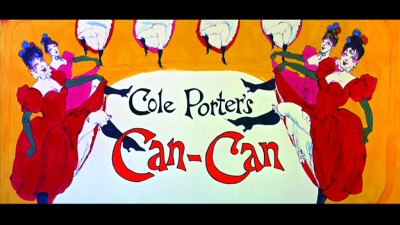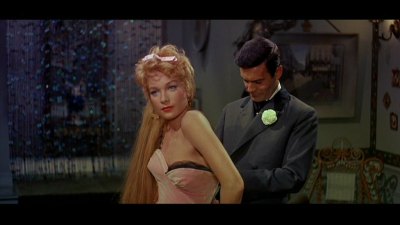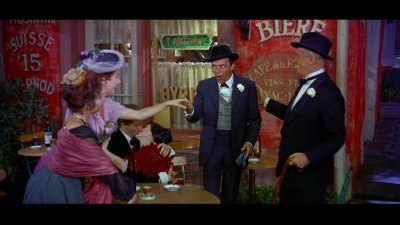| Reviews & Columns |
|
Reviews DVD TV on DVD Blu-ray 4K UHD International DVDs In Theaters Reviews by Studio Video Games Features Collector Series DVDs Easter Egg Database Interviews DVD Talk Radio Feature Articles Columns Anime Talk DVD Savant Horror DVDs The M.O.D. Squad Art House HD Talk Silent DVD
|
DVD Talk Forum |
|
|
| Resources |
|
DVD Price Search Customer Service #'s RCE Info Links |
|
Columns
|
|
|
Can-Can
Mais non! Helping inaugurate 20th Century-Fox's Marquee Musicals DVD line (which looks exactly like their Cinema Classics line), Cole Porter's Can-Can now appears for the first time on the DVD format. A medium-sized hit with the public in 1960 (but not with the majority of critics), and starring Frank Sinatra, Shirley MacLaine, Maurice Chevalier, and Louis Jourdan, Can-Can unfortunately lays there like a two-day old souffle: cold, flat, and unappetizing. Sure, there are some good songs featured here and there, but you can listen to those on the film's soundtrack album. Where's the great movie musical everyone in the cast seems so sure we're watching?

The original Broadway production of Cole Porter's Can-Can ran for two years at New York's Shubert Theatre, from 1953 to 1955. Starring Lilo, Hans Conreid, Peter Cookson and the sensational Gwen Verdon, the musical numbers were a hit with patrons, but critics had their reservations about the play's book -- a problem that would become more evident when the play was transferred to the big screen. Passing through a number of hands (including MGM's before being sold to Fox), Can-Can's screenplay problems were evident from the start. Originally, screenwriter Dorothy Kingsley was assigned by Fox to restructure the play. It's a pity the screenwriter of Sinatra's earlier gritty hit, Pal Joey, didn't stay on the project. Kingsley exited, and Charles Lederer was brought in, and while Lederer certainly wasn't any slouch in the screenwriting department, he was saddled with the same problem Kingsley had: a less-than stellar basic concept. Cutting out songs and characters from the original play, Lederer added the Francois Durnais character to suit the talents of Can-Can's lead actor, Frank Sinatra.
Once Sinatra came onboard, he chose as his leading lady Shirley MacLaine, who had excelled with Sinatra in their previous film together, the marvelous Some Came Running, directed by Vincent Minnelli. With Chevalier and Jourdan signed up to give Can-Can a more Gallic flavor, Fox was hoping for a little of the duo's previous Gigi magic to rub off on Can-Can. Problems with the script were ignored, and when the studio realized Can-Can didn't have enough good songs to support the film version, three Cole Porter standards were included to beef up the soundtrack: Let's Do It (Lets Fall in Love), Just One of Those Things, and You Do Something to Me.
Set in 1896 Paris in Montmartre, Can-Can tells the familiar three-way love triangle of cafe owner Simone Pistache (Shirley MacLaine), attorney Francois Durnais (Frank Sinatra), and judge Philipe Forrestier (Louis Jourdan). Evidently, Simone's cafe is the only venue for the outlawed folk dance, the can-can, which legal experts such as Forrestier have deemed a corruptive influence, thereby outlawing its performance. Durnais, the on-again, off-again lover of Simone, takes the opportunity to enjoy the can-can at Simone's cafe -- in the company of Judge Paul Barriere (Maurice Chevalier), a live-and-let live jurist who almost gets pinched with Durnais when the cafe is raided. Sitting on the bench for the trial of the dancers from Simone's café, Barriere convinces fellow judge Forrestier that he can't change the world, or legislate people's lives. Forrestier, who tries to get information out of Simone about the police officers who are paid off to keep quiet about the her can-can performances, becomes instantly infatuated with Simone, offering to marry her and turn her into a "respectable" woman. Flattered by his offer -- particularly since Durnais turns white every time the word "marriage" is mentioned -- Simone soon is caught in the middle between the two suitors, with kindly Judge Barriere benevolently presiding over the triangle.

I somehow missed Can-Can throughout the years, but I had read about it many times (then-Soviet premier Nikita Khrushchev's infamous visit to the set has always been a classic). And naturally, I'm a big fan of Cole Porter's music (that seems silly to write; does anybody actually not like him?), as well as the featured stars. However, Can-Can never achieves lift off, except during a few musical numbers, and even those aren't particularly special. And it's not difficult to know where to put most of the blame for Can-Can's leadenness, either: director Walter Lang. Lang, whom Fox even describes as a "journeyman" director in their notes for this DVD release, was not exactly known for his jazzy filmic style. Here, in Can-Can, his mid-auditorium camera placement never lets the material breathe; it's straight-jacketed into a proscenium arch, presentational style that resembles nothing more than a filmed play. And this constipated visual style distances us from the material. We never get closer than a medium shot to the actors, and for scene after scene, the camera is locked down like cement, with characters placed on opposite sides of the Todd-AO widescreen, talking or singing to each other. It's an incredibly stilted movie, not aided by the suffocating studio-bound production, either (why it was shot in Todd-AO is anybody's guess, but the process is ill-served by Lang's sensibilities).
For Can-Can to succeed, it either has to be fluffy light, like a souffle, taking the romance elements of the plot and turning them ironically on end to comment on the supposedly naughty aspects of French lovemaking and the can-can dance, or it has to have a coarse, vulgar energy to it, like the can-can dance itself, to get across the period flavor. Sadly, Lang's directorial choices don't come anywhere near either one of those tones, instead opting for a lumbering, static, and often times shrill (when it should be lively and energetic) presentation that's sleep-inducing. It's not all Lang's fault, though. The dance numbers aren't anything to write home about, either. While the "Garden of Eden" number is fairly entertaining, most of the others -- including the actual can-can and particularly Shirley's apache dance number -- are indifferently staged and performed. Watching John Huston's brilliant Moulin Rouge, and comparing the air of vulgarity and gaiety he manages to bring to his dazzling dance sequences next to Lang's straight-ahead, distant recording, it's not surprising that Fox would throw out a backhanded compliment to Lang like "journeyman" in their DVD liner notes.
So if the camera isn't moving, and the dance sequences are boring, what's left to Can-Can? Certainly not the script, which comes off as pedestrian and lugubrious. There's a lot of yakking in Can-Can, when there should be a lot of singing and dancing. And when the characters do sing, they sing their songs in tacky sets that are quite shocking when you consider the studio resources that went into this very expensive musical. The actors seem off their game, too. Sinatra, who's stuck in a one-dimensional role that was invented for the movie, does his usual superlative job singing, but he's on autopilot during the dramatics. Sinatra, a wonderfully instinctive actor infamous for demanding single takes if possible for all his scenes, clearly isn't engaged by the slight material, something that always sunk him on screen. MacLaine, who's usually so pert and delightfully goofy whenever she plays a role like Simone, comes off curiously arch and frazzled here; it's not one of her memorable performances. Jourdan is courtly and nothing more (perhaps he smelled a stinker in the making), and Chevalier does his usual continental-man-about-town bit that had already been perfected in Gigi. In short, the direction, the screenplay, the musical numbers, and the acting all come up short in Can-Can. To sum up: Can-Can can't.

The DVD:
The Video:
In the Digital Restoration bonus feature included in this Can-Can DVD, Fox states that 138 hours were spent cleaning up "the original elements" of Can-Can. The transfer here does look markedly improved over the previous 1993 video transfer that is shown in comparison. The aspect ratio has been returned to its proper Todd-AO 2.2:1 framing, and the colors are incredibly bright and saturated. But I still noticed several instances of color breathing and shifting that were rather stark (as always, I checked these scenes on several monitors, just to be thorough). I'm fairly sure that the "original elements" used here came from a 35mm reduction print, not the original 65mm negative or the 70mm prints (as with most true Todd-AO releases, only a few 70mm prints were struck for "road show" presentations -- the majority of prints were 35mm reduction prints for cinemas that didn't have the specific Todd-AO projectors or screens to show the 70mm print). It's curious that Fox doesn't specifically outline what the "original elements" are -- something they usually do in their other restoration comparisons.
The Audio:
The Dolby Digital English 5.0 Surround audio mix comes pretty close, I would imagine, to that discreet six channel wonder called Todd-AO sound. The audio mix for Can-Can is one of the liveliest I've heard on DVD this year. Wonderful speaker action, with plenty of spatial effects spread out through the speakers. There's also a French version of this mix, along with a Spanish mono. English and Spanish subtitles are included, along with close-captioning.
The Extras:
There are quite a few extras on the second disc of this Can-Can DVD. First up, A Leg Up: The Making of Can-Can clocks in at twenty minutes; it's more than informative on the background of the production, and hints of the compromised nature of the film manage to come through in the commentary. The ten-and-a-half minute The Classic Cole Porter featurette looks at the career and work of Cole Porter. Book by Burrows: The Man Who Wrote Can-Can is an eight minute look at the writer of Can-Can's book. The Restoration Comparison looks at the work done on the print for this DVD transfer. The original theatrical trailer is included, along with still galleries that include an interactive press book, souvenir program, behind-the-scenes and production stills. Probably the best bonus is the option to listen to the isolated musical score. There's an informative tri-fold booklet giving some additional background on the film, as well as four sepia-toned 4 x 6 stills that Fox calls "lobby cards," tucked into a sturdy envelope. I've seen these in other Fox DVD packages, and I wonder what the average DVD buyer thinks of them, and if they even remember the real "lobby cards" that the studios used to produce for publicity, and which were displayed in theater lobbies.
Final Thoughts:
The cast is impeccable, the songwriting is from one of the theatre's masters, but the direction lets them down badly, turning Can-Can into a lumbering, stilted bore. Everything is off in this ill-conceived movie musical, with the square, straight-ahead filming style diametrically opposed to the vulgar, coarse nature of the film's supposed inspiration: the can-can dance. Fans of the stars may want it to complete their collections; Cole Porter enthusiasts may enjoy hearing some of those lovely songs, but for most viewers, a rental is recommended first. If it's an unknown property to you, and you're thinking of buying rather than renting Can-Can first, don't-don't.
Paul Mavis is an internationally published film and television historian, a member of the Online Film Critics Society, and the author of The Espionage Filmography.


|
| Popular Reviews |
| Sponsored Links |
|
|
| Sponsored Links |
|
|
| Release List | Reviews | Shop | Newsletter | Forum | DVD Giveaways | Blu-Ray | Advertise |
|
Copyright 2024 DVDTalk.com All Rights Reserved. Legal Info, Privacy Policy, Terms of Use,
Manage Preferences,
Your Privacy Choices | |||||||















